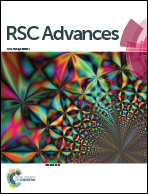Potential apoptosis inducing agents based on a new benzimidazole schiff base ligand and its dicopper(ii) complex†
Abstract
Synthesis, characterization and antiproliferative activity of a new benzimidazole based Schiff base 2-(1-methyl-1-H-benzimidazol-2-yl)phenyl)imino)methyl)phenol (HL) and dicopper(II) complex [{Cu(L)NO3}2] (CuL) containing L− has been described. Both HL and CuL have been meticulously characterized by satisfactory elemental analyses, FT-IR, NMR, ESI-MS, electronic absorption and emission spectroscopy, and their structures unambiguously determined by X-ray single crystal analyses. Titration studies (absorption and emission) revealed interaction of the ligand and its dicopper(II) complex with DNA/BSA and stronger affinity of the CuL relative to HL. Binding of the HL and CuL with DNA/BSA have been validated by in silico studies and their cytotoxic effect on human breast cancer cell lines (MCF-7) by MTT assay. IC50 values (458 μM and 22 μM for HL, CuL) clearly suggested substantial cytotoxicity of the complex CuL toward MCF-7 compared to the ligand HL. Greater antiproliferative efficacy of the CuL in contrast to HL has been evidenced by fluorescence activated cell sorting (FACS) and AO/EB fluorescence staining. The possible mode of the apoptotic pathway for CuL has further been affirmed by reactive oxygen species (ROS) generation studies.


 Please wait while we load your content...
Please wait while we load your content...